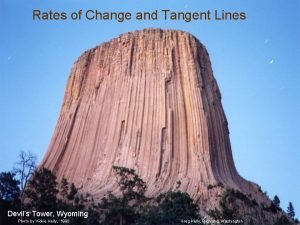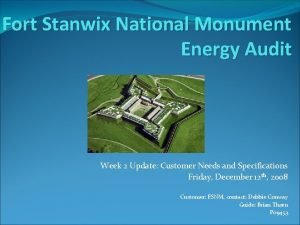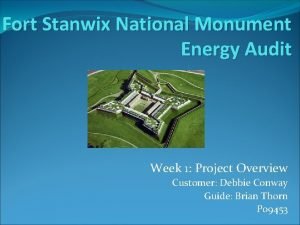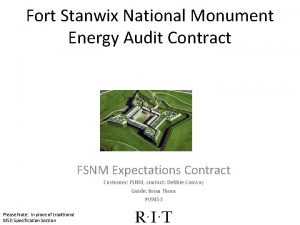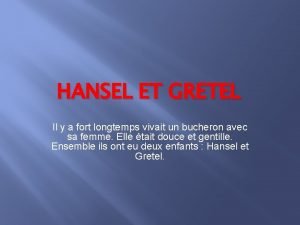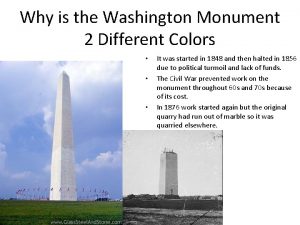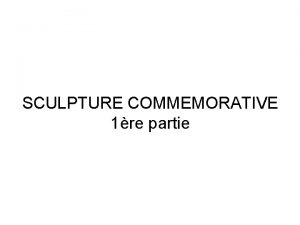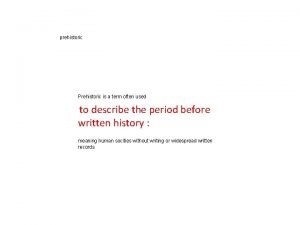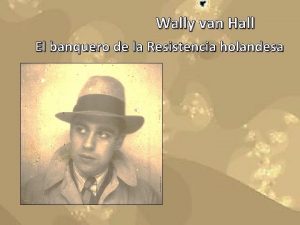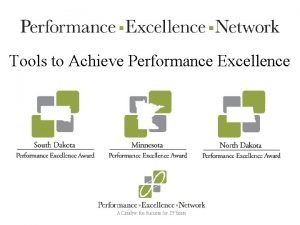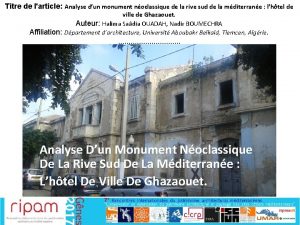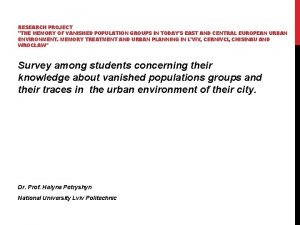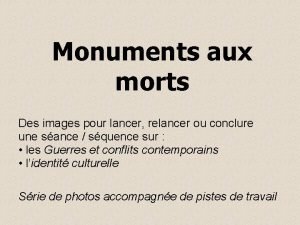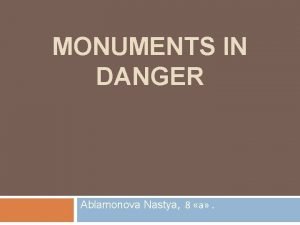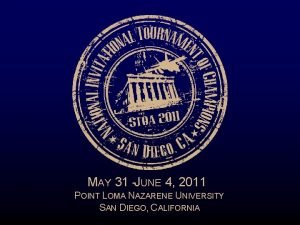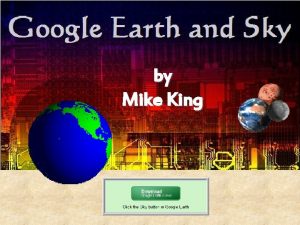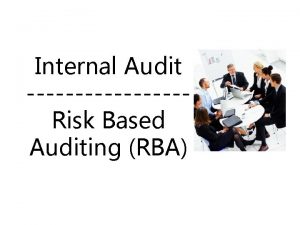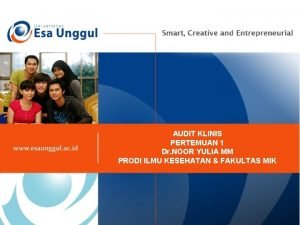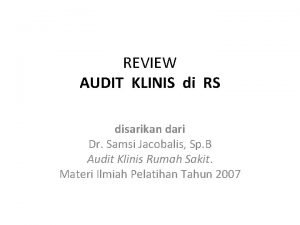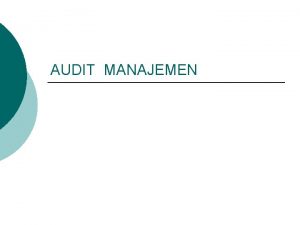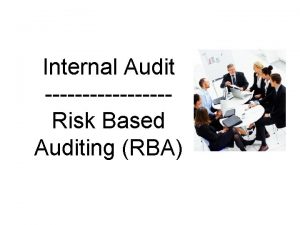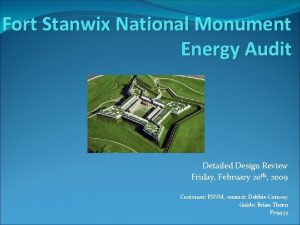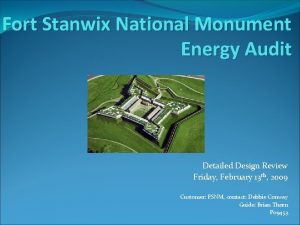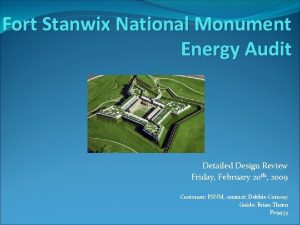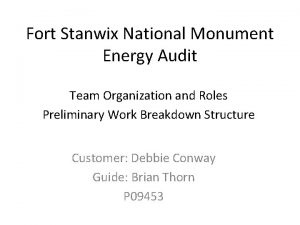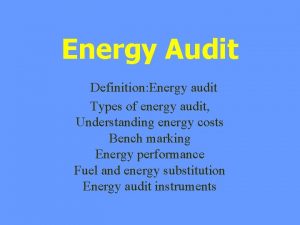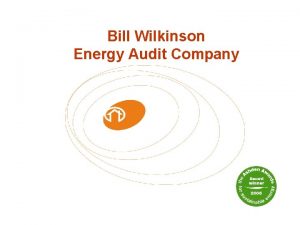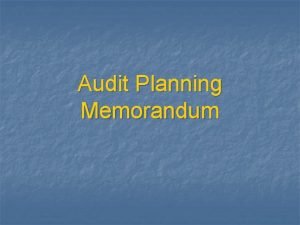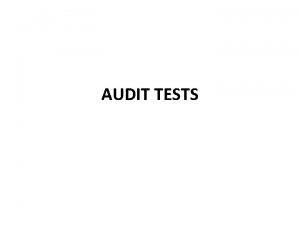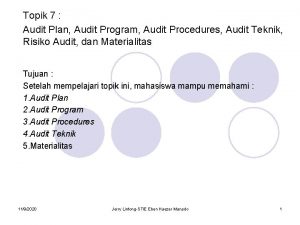Fort Stanwix National Monument Energy Audit Design Review


































- Slides: 34

Fort Stanwix National Monument Energy Audit Design Review Monday, January 19 th, 2009 Customer: FSNM, contact: Debbie Conway Guide: Brian Thorn P 09453

Project Description Project Background: Who: Fort Stanwix National Monument (FSNM) part of the National Park Service (NPS) Where: FSNM is situated in Rome, New York. What: The Fort consist of three primary energy use locations: the Willet Visitor Center, the Fort and a maintenance shed. In 2005 the addition of the Willett Center has dramatically added to FSNM’s energy consumption. Why: The Willett Center consumes far greater energy than original expectations, and currently accounts for 2/3 rds of FSNM total energy cost. Align FSNM with the NPS green initiative Problem Statement: The overall objective of this project is to identify short and long-term opportunities to reduce energy consumption and energy costs at the Fort Stanwix National Monument, and implement a renewable energy demonstration-scale model.

Customer Needs Rational for Customer Needs based on: • Project readiness packet • December 2 nd phone interview with FSNM – Debbie Conway • December 13 th onsite visit with Debbie and Todd • Key statement: reduce current total cost of energy at FSNM to offset the impact of potential ‘green’ energy opportunities and conservation measures

Specifications – Traditional approach Need # Rank Description Metric Units Margina l Value CN 1 1 Reduce total cost of energy at FSNM Reduction in total projected monthly energy costs considering implementation costs US$ >$350 CN 2 1 Recommendation of potential energy saving opportunities # of Energy Conservation Measure opportunities # >5 options CN 3 1 Evaluate energy saving opportunities budget impacts Economic implications of the energy saving opportunities – ROI, investment costs Time US$ CN 4 1 Understand current energy use Perform an energy audit of FSNM focused on the Willett Visitor Center - Highest Energy Use System Cost CN 5 1 Evaluate current gas and electricity billing structure Electricity - ∆ monthly $/k. W Gas - ∆ monthly $/Therm $/k. W $/Therm < 30% < 10% CN 6 1 Investigate alternative ESCOs and billing structures Electricity - %∆ monthly $/k. W Gas - %∆ monthly $/Therm $/k. W $/Therm < 30% < 10% CN 7 2 Analyze impacts of a 'green' billing structure Change in ($/k. W*yearly consumption) vs. tax incentives/year Ideal Value

Project Specs – Expectations Project Specifications: • Attempted traditional approach, it was not inline with an energy audit, not a product �Defined specifications in terms of an energy audit �Project specifications are the agreed upon expectations of the total energy assessment process and outcome – ‘What is included and captured’ �FSNM specifications are expectations regarding the explicit actions, information, analyses and results that the entire energy assessment project will contain �Definition of the content in the final assessment report �Current Specification is posted on EDGE for review

Project Scope & Schedule Objectives/Scope: • Conduct pre-assessment data collection • Perform on-site energy assessment • Develop energy savings opportunities • Review Current electricity billing structure • Indentify and evaluate alternative energy service companies (ESCOs) • Implement a pilot renewable demonstration-scale energy project �Goals for end of Winter Qtr: � Complete ECM analysis with preliminary implementation plan � Preliminary ‘What-if’ analysis – software driven �Goals for end of Spring Qtr: � Sustainable/renewable energy project plan and model complete � Training program complete � Alternative ESCO options � Final report with categorized ECMs and implementation plan

Data Collected & Obtained �Provide an idea of how are analysis are driven �Documents available upon request Document Comment 2 years of energy bills: Willett Center, Fort, Shed Gas vs. Electric Floor plan for maintenance shed and Willett Center Willett center zones and 2007 construction changes Climate controlled conditions specifications Systems schedule documentation Operating hours for several systems Gathered from Trane Tracer system

Utility Analysis Structure: Establish 1 year baseline year (September 2007 – September 2008) to evaluate disaggregate electric costs and natural gas production percentages. Purpose: Understand the basic energy usage to identify major areas as candidates for energy savings by establishing a benchmark. Evaluate the current baseline production versus space heating/cooling to identify possible HVAC savings. Willett Center Energy: Demand: Gas: $0. 1401 /k. Wh $0. 3849 /k. W-month (average cost over 2 years) $1. 2133 /therm Main Fort and Maintenance Building Energy: $0. 1467/k. Wh Demand: $. 3456 /k. W-month (average cost over 2 years) Gas (Main Fort): $1. 2549 /therm Gas (Maintenance) : $1. 2067 /therm

Rate Structure – Graphical Analysis (1 of 3)

Utility Analysis Baseline – Willett Center - Operating hours: open 362 days per year (3 holidays) - 7 days per week: 9 am – 5 pm - 2007 construction changes - July Concert spike Demand Consumption for Baseline Year (Sep '07 - Sep '08) 30000 25000 10000 5000 но т- 06 я 0 де 6 к 0 ян 6 вф 07 ев ма 07 р0 ап 7 рма 07 йию 07 нию 07 л 0 ав 7 г-0 се 7 н 0 ок 7 т0 но 7 я 0 де 7 к 0 ян 7 вф 08 ев ма 08 р0 ап 8 рма 08 йию 08 нию 08 л 0 ав 8 г-0 се 8 н 08 0 ок Energy Consumption (k. Wh) 20000

Utility Analysis Baseline – Willett Center - System schedule: pull mfg specifications to determine greatest energy consumer - Disaggregate costs: Willett Center electricity: - Energy: 58% - Demand: 42%

Baseline Results �Use as bench mark for change comparison and insight into ECM options �Main focus areas for ECMs �Lighting usage �HVAC systems �Building Efficiency

Building Envelope Analysis Data Sources • R-Values for the walls and ceilings were found from the Utica Department of Codes • R-Values for windows and doors will be estimated by the Energy. Smart codes • Dry Bulb Ambient Temperature Data is taken from TMY 3 data for the Utica area. – The coldest day of the year recorded by the TMY 3 data is March 3 rd, 2005. – The outside temperature was -23 °C.

Envelope Description • The windows in the foyer are a large source of heat loss in the building, and the space is conditioned to make visitors comfortable. • Walls throughout the building should be built to modern construction codes. • The walls dividing the two main zones in the center could potentially use more insulation to prevent leakage into the climate controlled archive area. • The ceiling area crawlspace was very warm. This could make the ceiling insulation a viable way to save energy.

Calculations A – Outdoor siding B – Paneling C – Insulation D – Wall Studs E – Drywall Tamb A B C & D E Tinside

Calculations (working) Calculations to be completed after next onsite visit 1/23 R-Value U-Value Surface Windows Doors Walls Ceiling ft 2 h °F/Btu m 2 °C/W Btu/ft 2 h °F W/m 2 °C 2. 86 0. 50 0. 35 1. 99 21 3. 70 0. 048 0. 27 49 8. 63 0. 020 0. 12 Inside Temperature 70. 0 °F 21. 1 °C Date of Max 3/3/2003 Time of Max 7: 00 AM Maximum Energy Loss (k. W/m 2) 87. 27 11. 87 5. 09 Amb. Temp of Max (°C) -22. 8 Annual Energy Loss (k. W/m 2) 227687 30978 13276

Lighting System The buildings use a range of different bulbs for different purposes. Most rooms in Willett Center have occupancy sensors. Displays have spotlight bulbs.

Lighting System The buildings use a range of different bulbs for different purposes. Most rooms in Willett Center have occupancy sensors. Displays have spotlight bulbs. Most Common Bulbs: 4 ft T 8 bulbs are used in most of the back rooms, archives, and offices. Efficient and long life 32 Watts Best way to conserve energy is to keep lights off.

Further Systems Analysis �Still need to approximate operation times for the lights in each room. �This will be estimated based on room function and building operational hours. �The number of lights in each room needs to be counted �Investigating the efficiency of HVAC system �Faced with climate controlled constraints

First Onsite Visit �First site visit, Saturday 12/13 �Refined customer needs, tour, pictures and data collection �Completed utilities bills database – current energy profile �Gathering energy consumption of current systems �Analyze building envelope

FSNM Energy Conservation Concepts �Broken into short and long term concepts �Short term: operation & maintenance approach, low cost replacements and or upgrades �Long term: retrofit through replacement, upgrade systems �Generated from site visit and current available data �Short term: �Willett Center Concepts: � Reduce lighting system load during non-peak operation � Adjust operational hours during non-peak operations � Utilize window shades more efficiently for heating/cooling � Use high efficiency light blubs where possible � Repair duct leaks � Adopt all energy star products

FSNM Energy Conservation Concepts �Short term continued: �Willett Center � Improve door and window seals � Implement tinted or reflective glass � Adjust exhibit zone temperature range � Install ceiling fans in exhibit section � Insult attic space above exhibit area �Fort and Site-wide concepts: � Employee training program � Solar powered walk way lights � Replace T 12 with T 8 lights � Replace kitchen and auditorium equipment �Long term (ongoing concept generation, data, software driven): �Replace AC units in Fort �Insulate attic space more efficiently in Willett Center �Implement heat pumps (renewable energy)

Implementation Plan �Aspects to include in implementation plan �Cost of new equipment, software, etc �Return on investment (ROI) & payback �Steps required to implement – construction? �Difficulty of implementation �Timing �Economic Analysis of each ECM, sustainable/green option will be conducted �Researching software approach

Energy Service Company (ESCO) Evaluation Structure Breakdown of current client contract with National Grid. Evaluation of other ESCO services in Rome, NY by developing a comparison chart based on a survey analysis. Purpose Identify ways National Grid may be able to provide energy savings or greenergy for Fort Stanwix. Develop energy savings plans as alternatives to FSNM current service. Plan - Make contact with alternative ESCOs - Request data regarding billing structure - Compare alternatives against current service - Present findings: due to contract may be difficult to opt out

Current Energy Service – National Grid Disadvantages The Fort Stanwix contract with National Grid is unlikely to be altered so energy savings may be hard here. Advantages National Grid offers Energy Profiler Online™ (EPO) which helps in the understanding of how electricity is used within the operation over time. Some aspects of the tool include: Manage your energy consumption—identify what’s normal and abnormal usage See the results of your energy efficiency and conservation efforts at each site Shift your energy usage to lower-cost time periods and move dollars to your bottom line Use the load data information as a guide for shopping wisely with power suppliers National Grid also offers 4 suppliers of green energy in their Green. Up program.

Comparison of ESCOs – National Grid as an Example (1 of 2) Questions ESCO name National Grid Costs Price (in cents/k. Wh) including taxes of electricity? $. 14/k. Wh (Willett Center) Does this price vary by month or day? month Are there fees for service besides electricity? yes Is gas available as well? yes Price for gas (in therms)? $1. 2133/therm (Willett Center) Contract Terms **These terms can only be discussed with the customer and are not available through National Grid to the public. How long will this price remain in effect? Or how long will the electric service contract be effective? nondisclosed** Do additional contract terms apply? nondisclosed** What are the responsibilities of the customer? nondisclosed**

Comparison of ESCOs – National Grid as an Example (2 of 2) Special Needs/ Energy Conservation Do you offer ways to help the customer save energy or use energy more efficiently? yes, Energy Profiler Online (EPO) - additional $50/mo Is a form of green energy available or how is your company "green"? yes, Green. Up option - 4 green energy providers available Environmental What types of power plants does your company use? natural gas, hydroelectric Billing Will there be separate bills or one bill for energy and delivery? same bill Is budget billing available? (not really needed for Ft. Stanwix) n/a

Energy Audit Software Rational: Way to analyze baseline buildings Evaluate impacts of various ECMs Play ‘What if’ analyses for each ECM HAVC and building envelope analysis was critical selection criteria Used government sponsored database: http: //apps 1. eere. energy. gov/buildings/tools_directory/subjects. cfm/pagen ame=subjects/pagename_menu=whole_building_analysis/pagename_su bmenu=energy_simulation

Software Selection Good HVAC Modelling Moisture Lighting Control Option Module Daylight Option Solar Within Implementation Budget Comments Ak. Warm BSim Program Suite. Vague lighting module Design. Builder EA-QUIP Retrofit by answering questions EZ Sim Bill Auditing HOT 2000 No room-by-room HVAC modelling IDA Indoor climate Energy For HVAC designers Para. Sol No HVAC input Pvcad Special for PV system implementation. (German) RL 5 M No solar system. Error check! Room Air Conditioner Cost Estimator Web-based + cost estimation Solar. Shoe. Box SUNREL TRNSYS EN 4 M Energy in Commercial Buildings Economic analysis

Software Choice Most comprehensive program Somewhat expensive Talk with Margaret Bailey Future Institute’s use Better alternatives

BSim � Sim. View � For editing the geometry, materials and installations � Tsbi 5 � Control of the indoor climate, thermal and moisture � Xsun � Sunlight and shadows � Sim. Light � Dailight calculations (use of artificial light) � BV 98 � Danish regulations � Sim. DXF � Import CAD drawings � Sim. DB � Database with construction materials � Sim. PV � Calculate electrical yield from solar panels

Infrared Imaging Dr. Joe Pow Needs faculty/staff to get the camera Used for distance sensing in aircrafts Used to detect air leaks during an energy audit

Risk Assessment �Software order delays �Software learning curve �Feasibility of ECM implementation – FSNM funding �Sustainable energy option – codes, law �Proximity to FSNM �Validity of assumptions �Ability to capture and quantify energy consumption without ‘professional equipment’

FSNM ‘Concept’ Generation � 2 project components have concept generation needs: �Energy conservation measures (ECMs) applicable to FSNM �Pilot renewable energy scale-project �At this point, only high level renewable energy concepts �Additional research and project components required �Renewable energy concepts for further evaluation: � Solar Power � Wind Power � Geothermal Power � Biomass
 Devils tower national monument
Devils tower national monument Monument energy
Monument energy Monument energy
Monument energy Fsnm
Fsnm Je suis fort fort oui plus que vainqueur
Je suis fort fort oui plus que vainqueur Il y a fort fort longtemps
Il y a fort fort longtemps Why washington monument two different colors
Why washington monument two different colors Jochen gerz monument contre le racisme
Jochen gerz monument contre le racisme Prehistoric monument dan word
Prehistoric monument dan word Symbol of multiculturalism
Symbol of multiculturalism Root cause analysis tools
Root cause analysis tools 5 whys washington monument
5 whys washington monument Wally van hall
Wally van hall Washington monument
Washington monument Monument
Monument Who is he
Who is he Dorian gray portree film
Dorian gray portree film Lancer monument
Lancer monument Monument
Monument Monument
Monument Chris jeub monument academy
Chris jeub monument academy Teardrop monument gift from russia
Teardrop monument gift from russia What is the real name of the monument
What is the real name of the monument Washington monument google earth
Washington monument google earth Energy energy transfer and general energy analysis
Energy energy transfer and general energy analysis Energy energy transfer and general energy analysis
Energy energy transfer and general energy analysis Perbedaan audit konvensional dengan audit berbasis risiko
Perbedaan audit konvensional dengan audit berbasis risiko Perbedaan audit medis dan audit klinis
Perbedaan audit medis dan audit klinis Beda audit medis dan audit klinis
Beda audit medis dan audit klinis Penyelesaian audit dan tanggung jawab pasca audit
Penyelesaian audit dan tanggung jawab pasca audit Kerangka kerja audit manajemen
Kerangka kerja audit manajemen Prosedur audit bottom-up dan audit top-down
Prosedur audit bottom-up dan audit top-down Vouching
Vouching Perbedaan audit konvensional dengan audit berbasis risiko
Perbedaan audit konvensional dengan audit berbasis risiko Audit latin meaning
Audit latin meaning
